Summary: Can VLC compress video? The answer is YES! And here in this post, you will learn how to compress video with VLC in 6 ways. Detailed steps are included, with real test data and image quality comparison demonstrated.
VLC, the free and open-source media player software, comes with impressive compression compatibility. Offering several options to reduce video file size, the VLC video compressor allows you to compress MP4/MKV/MOV 4K HD videos for easy storage, or fast uploading on YouTube, Facebook, Twitter, Instagram, etc. And it would also be quite helpful to use the VLC video compression tool when sharing some large videos with your friends via Email, WhatsApp, and more. And here in the post, we have pieced together a full tutorial, explaining how to compress video with VLC in 6 best ways.
- 1. Convert Video Codec to Compress Video with VLC
- 2. Downscale Video Resolution to Compress Video with VLC
- 3. Descreate Frame Rate to Compress Video with VLC
- 4. Descreate Frame Rate to Compress Video with VLC
- 5. Reduce Video Bitrate to Compress Video with VLC
- 6. Change Audio Parameters to Compress Video with VLC
- Best VLC Video Compressor Alternative to Compress Video in One Click 👍
 Heads up: If you're new to video compression, using VLC might take a bit of trial and error. You'll need to understand some basic video encoding concepts to get good results. For a simpler solution — like compressing a batch of videos to your desired size with just one click — we recommend VideoProc Converter AI.
Heads up: If you're new to video compression, using VLC might take a bit of trial and error. You'll need to understand some basic video encoding concepts to get good results. For a simpler solution — like compressing a batch of videos to your desired size with just one click — we recommend VideoProc Converter AI.

VideoProc - The Best Alternative to VLC for Video Compression
- Instant compression – Enter the target size or set a compression ratio (10%–90%).
- 7 compression ways – Options tailored for both beginners and advanced users.
- No visible quality loss – Powered by High-Quality Engine with x265/AV1 encoding.
- AI-powered tools – Super Resolution, Frame Interpolation, Stabilization, etc.
- Up to 47× faster – Thanks to full GPU acceleration technology.
![]() Excellent
Excellent ![]()
What Should You Know Before Compressing Video via VLC
Before we jump into the specifics of using VLC to compress your videos, it's genuinely helpful to get a handle on what makes video files big in the first place. At its core, the total size of a video file really just comes down to how much data is packed into every single second. You can pretty much sum it up with a simple idea:
Video File Size ≈ How Long It Is (Duration) × How Much Data Per Second (Bitrate)
While the video's duration and its bitrate are definitely the main culprits behind large files, several other settings that play a significant role too. (I'll make detained explain on the how-to parts). Below is a quick understand.
- Video codec: The method used to compress and encode the video. Some codecs are much better at shrinking file size without sacrificing quality.
- Resolution: Higher resolution (more pixels) means more data per frame.
- Frame rate: More frames per second = more data per second.
- Audio settings: Audio codec, bitrate, and sample rate also contribute, though less than video settings.
VLC actually gives you control over all of these key parameters. By making smart adjustments here, you can seriously cut down your video's file size. So, with that basic understanding covered, let's look at 6 effective ways you can actually put this into practice using VLC.
Method 1. Compress Video with VLC by Transcoding
The video codec is the algorithm that compresses/encodes video. More efficient codecs produce smaller files at the same visual quality. Modern high-efficiency options include HEVC (H.265), VP9, and AV1 (all more efficient than H.264/AVC and VP8). In practice, HEVC/VP9 can reduce size by up to ~50% versus H.264 at similar quality, and AV1 is typically another ~20–30% smaller than HEVC/VP9. So, in VLC you can compress a video by transcoding it to a more efficient codec — e.g., HEVC, VP9.
📌 Currently, VLC doesn't support AV1 output. If you want to achieve extreme compression without sacrificing picture quality, you can try VideoProc Converter AI, which supports AV1 encoding and offers a much easier way to compress videos.
Free download the VLC video compressor and follow the step to reduce video size in VLC.
Step 1. Click the Media > Convert/Save, and click Add to load the video files that you wish to compress in VLC. Tap on Convert/Save again when you are done.
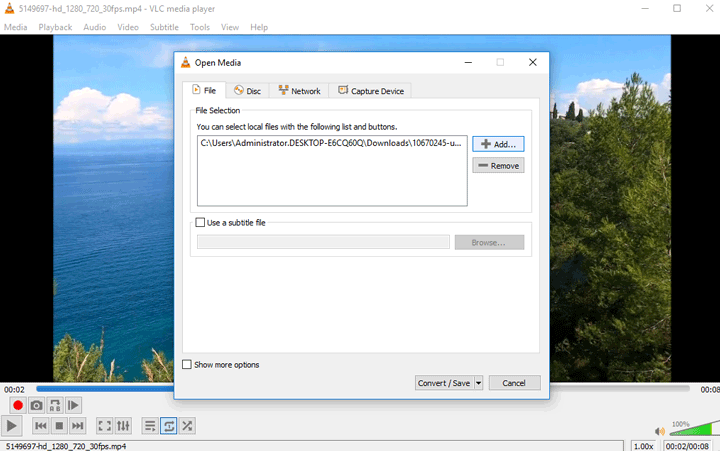
Step 2. Select Video – H.265 + MP3 (MP4) or Video – H.264 + MP3 (MP4) as your output profile.
Tip: If you fail to find the video codec you wish to use, click on the Wrench icon next to the Profile option and access the Video codec panel, where you can find more video codec formats to work with.
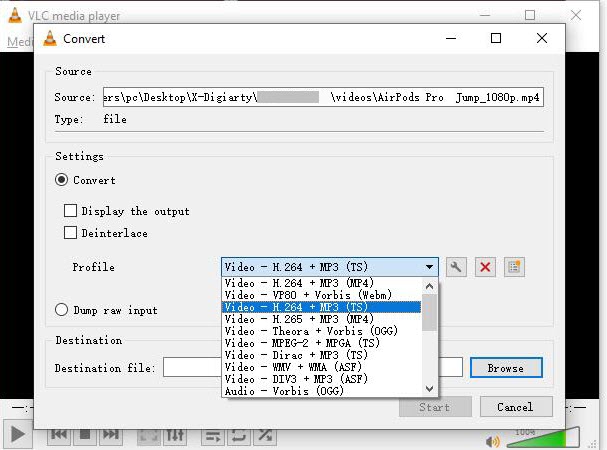
Step 3. Click Browse to find a destination folder, and hit Start to compress video using VLC.
Method 2. Compress Video with VLC by Downscaling the Resolution
To get a better understanding of the second and third techniques used in VLC compress video, it is essential to learn the four major factors that determine video file size: resolution, frame rate, bitrate, and coding scheme.
Thus, downscaling resolution via VLC offers a direct path to making a video smaller. However, just keep this in mind: it's generally best to downscale gradually – for instance, moving from 4K down to 2K, or from 2K to 1080p – to avoid a noticeable drop in visual quality.
Step 1. Again, click on Media > Convert/Save, and add the source video to the VLC video compressor. And click on Convert/Save.
Step 2. Select an output profile such as HD (720p) or SD (480p) or a smaller file size to downsize your 4K to 1080P or 720P.
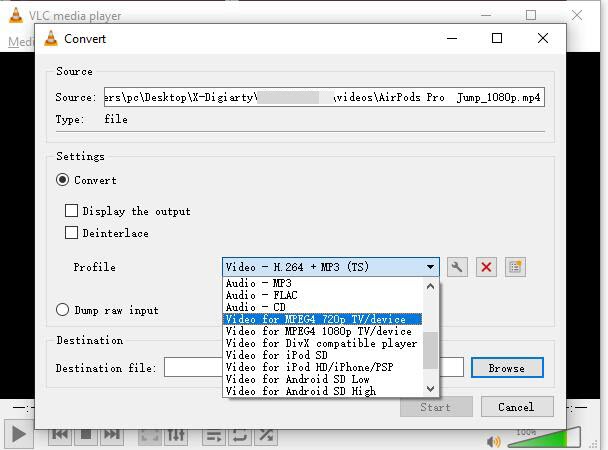
Step 3. Click Browse to select a destination folder, and hit Start to compress video with VLC.
Method 3. Compress Video with VLC by Adjusting the Frame Rate
Frame Rate tells you how many still images flash by every second (common examples are 24FPS, 30fps, 60fps). A higher frame rate gives you smoother motion, especially in fast scenes, but you're essentially storing more pictures per second, which adds to the overall data load. Thus, you can compress video with VLC by reducing the frame rate.
Note:
However, for action-packed or cinematic videos, lowering the frame rate can make the footage look choppy—so it's best to use this VLC compression method only when it fits certain situations:
- Low-motion videos like interviews, webinars, tutorials, or slideshows can usually be dropped from 30fps to 24fps (or even 20fps) without a noticeable difference.
- Mobile or low-bandwidth viewing (like videos for messaging apps) can still look fine at 15–20fps, especially when quality isn't a top concern.
- Security footage often runs at 10–15fps, since the goal is just to capture general movement, not smooth playback.
Step 1. Hit Media > Convert/Save. Choose +Add and select the original video for adding to VLC. Hit Convert/Save. After that, select Video – H.265 + MP3 (MP4).
Step 2. Click the wrench icon next to the Profile option, come to the Profile Edition panel, and hit the Video Codec tab.
Step 3. Lower the Frame Rate to 30fps, as it is enough for the human eye can see; and downgrade the high bit rate properly, and generally, 2160 4K video looks clear when setting the bitrate at 35Mbps or higher, 1080p HD at 8Mbps or higher, 720p HD at 5bps or higher…
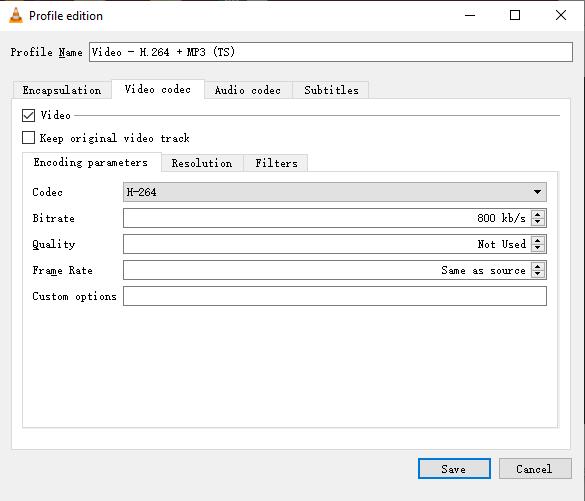
Step 4. Select a destination folder, and hit Start to start the video compression in VLC media player.
Method 4. Compress Video with VLC by Adjusting the Bitrate
The bitrate of your video is one of the most direct and powerful controls you have over its final file size. Bitrate dictates how much data is allocated to each second of video, directly impacting both the file size and the visual quality. By reducing the bitrate from its original value, you can achieve substantial file size savings. But, noticeably, this usually brings noticeable loss in quality.
Step 1. Click on Media > Convert/Save. Hit +Add and choose the source video that needs to be compressed via VLC.
Step 2. Click on Convert/Save on this panel. Choose Video – H.265 + MP3 (MP4).
Step 3. Click the wrench icon to navigate yourself to the profile edition panel. Click Video Codec.
Step 4. Adjust the bitrate to a lower value than the original.
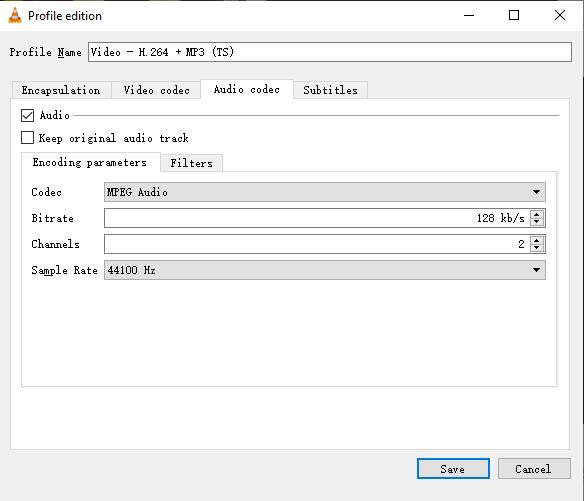
Note:
Lowering the bitrate is a key way to reduce file size, but be cautious not to set it too low. For instance, with SDR 24 fps video, it's generally not recommended to set the bitrate below 22 Mbps (22582 kb/s), as doing so can lead to noticeable pixelation or loss of detail.
Method 5. VLC Compress Video by Cutting Unnecessary Parts
The VLC video compressor does not offer a built-in option for cutting to remove unwanted segments. However, you can use the Record function to capture the desired and necessary clips and compress video using VLC without losing quality. To do that, open the VLC video compression tool:
Step 1. Load the video you wish to compress in the VLC video compressor and select the View > Advanced Controls in the menu, and a new toolbar should appear at the bottom of the preview window.
Step 2. Play the video or scroll around to the starting point from where you want to cut.
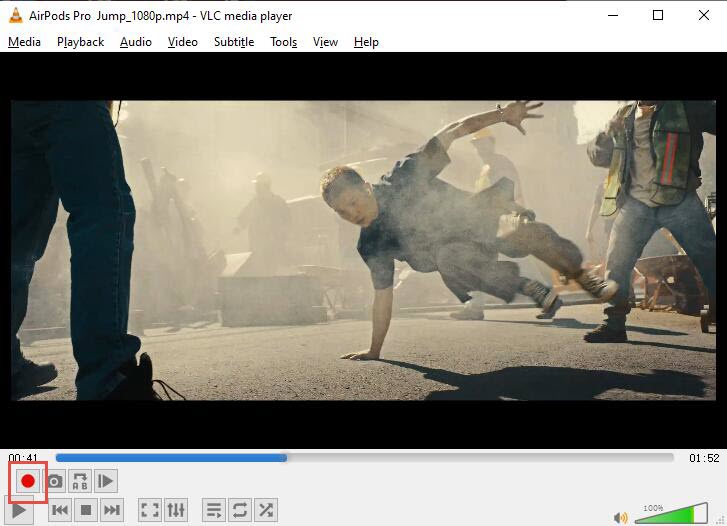
Step 3. Click on the red Record button, and once you reach the ending point, hit the Record button to stop to reduce video size in VLC. The trimmed video shall be automatically saved as a new video in your Videos folders on your PC.
Method 6. Compress Video with VLC by Adjusting the Audio Encoding
The VLC video compressor allows users to compress video without compromising image quality by reconfiguring the audio parameters like audio codec, bit rate, sample rate, and more. Note that working on the audio encoding parameters won't make much difference on your video size, but it is worth a shot, especially for those who are concerned about image quality with less regard to audio output in VLC video compression.
The Audio codec tab is located next to the Video codec tab, and simply click on the tab and adjust the audio codec, bitrate, channels, and sample rate to compress video using VLC.
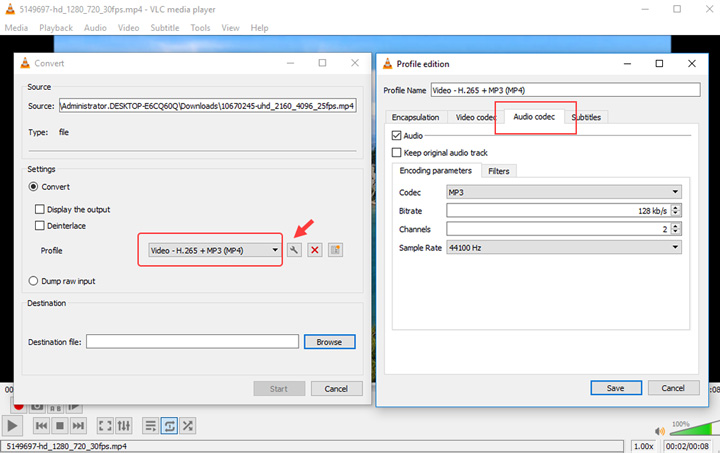
Try This Alternative Way to Shrink Videos: Easier & Better Quality
So, you've seen how to use VLC to compress your videos, and it's a solid option, especially considering it's free and you might already have it installed. However, it's worth being realistic: while VLC can compress, it's not its primary function, and for more demanding or frequent tasks, you might encounter some limitations. Things like not being able to set a precise target file size upfront, slower processing speeds and sometimes inconsistent results can become excessively larger than the original.
If you find yourself hitting these roadblocks, or if you simply need something faster and more streamlined specifically for video compression, we suggest you to try VideoProc Converter AI instead. With just one click, you can shrink video file sizes by up to 90% without any noticeable loss in quality. Even better, it now supports AV1 — alongside HEVC, H.264, and other VLC-supported codecs — offering an even better compression ratio while maintaining the same picture quality. For a quick overview of how VideoProc Converter AI that stacks up against VLC specifically for compression, take a look here:
| Feature | VLC Media Player | VideoProc Converter AI |
|---|---|---|
Codec/Encoding Settings |
|
|
Compression Options |
|
|
Size Reduction |
|
|
Output Quality |
|
|
Batch Processing |
|
|
AI Tools |
|
|
Extras |
|
|
Step 1. Free download VideoProc Converter AI, launch it, and click Compressor.

Step 2. Compress your video file size.
Import your source video(s). This batch video compressor allows you to directly specify the desired output file size or drag the compression ratio slider to reduce the video file size.

In addition, you can also reduce your video file size by:
- Increase the GOP value.
- Lower the target bitrate, frame rate, resolution, etc.
- Transcode to a more aggressive codec like AV1, HEVC, and H.264.
- Adjust the audio.
Step 3. Click Done to confirm the settings and then hit Run to compress the video.
As the best VLC video compression alternative, VideoProc Converter AI allows you to easily compress MP4 MOV, MKV, WAV, and other 370+ formats in one click. Plus, it also gives you the power to convert, download, edit, record, and more in one go. Free download the VLC video compressor alternative and enjoy a better compression rate and higher image quality now!
FAQs
1. Why does a compressed video in VLC have no sound or show a black screen?
This is a common codec mismatch or muxing issue in VLC. During compression, VLC may fail to correctly package the audio stream (such as AAC) into the output container (like MP4), or it may mishandle multi-channel audio tracks—resulting in silent playback or a black screen.
VLC workaround
Go to Profile Settings → Audio Codec, make sure Audio is enabled, and manually set the codec to MPEG-4 Audio (AAC). This often resolves missing sound issues, though it requires manual adjustment each time.
Alternative approach
VideoProc Converter AI uses an intelligent muxing system with Auto-copy technology, ensuring audio and video streams remain perfectly synchronized. It automatically selects compatible codec and container combinations, eliminating the trial-and-error process that often leads to silent or unplayable videos in VLC.
2. Can VLC batch-compress multiple videos? Why does it freeze?
VLC does not provide a true batch queue. Each output must be confirmed manually, and the process relies heavily on CPU resources, which can lead to freezes or crashes when processing multiple or large files.
VLC limitation:
- No unified batch workflow
- No global compression ratio across files
- No target file size control (e.g., "25 MB per video")
VideoProc Converter AI designed for batch compression allows multiple files to be processed in one queue, with shared settings or per-file size limits, and typically rely on GPU acceleration for better stability.
2. Why do compressed videos look blurry or "washed out"?
This often happens when HDR metadata is dropped or when color spaces are incorrectly converted (such as BT.2020 to BT.709) during transcoding. VLC's basic presets offer limited control over color space, bit depth, and quality retention, which can affect 4K or HDR footage. Using modern codecs like HEVC or AV1, along with smarter bitrate allocation, helps preserve color accuracy and detail while significantly reducing file size.

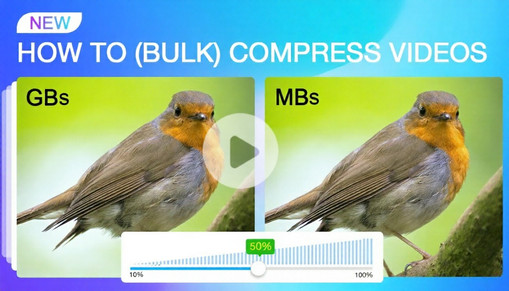

 Yes (manual, less intuitive)
Yes (manual, less intuitive) Set target size
Set target size Depend on the encoding settings
Depend on the encoding settings


